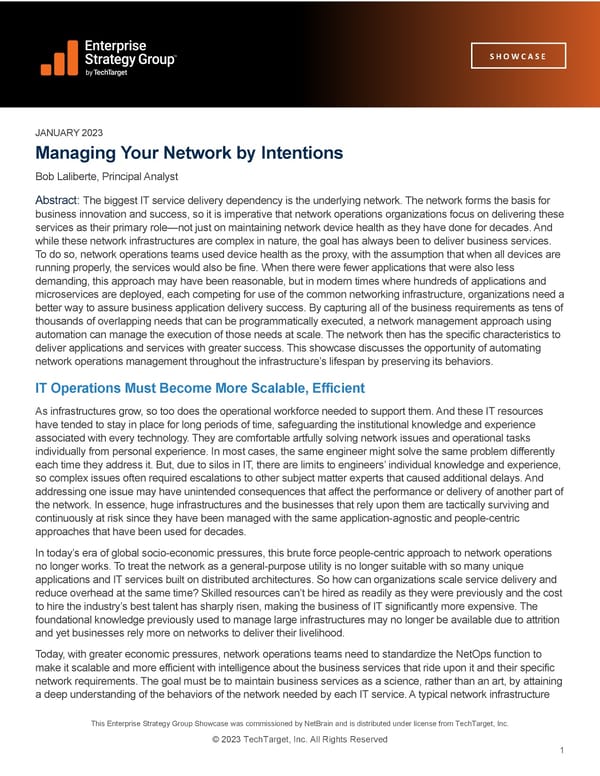ESG Showcase NetBrain Network Intent
SHOWCASE JANUARY 2023 Managing Your Network by Intentions Bob Laliberte, Principal Analyst Abstract: The biggest IT service delivery dependency is the underlying network. The network forms the basis for business innovation and success, so it is imperative that network operations organizations focus on delivering these services as their primary role—not just on maintaining network device health as they have done for decades. And while these network infrastructures are complex in nature, the goal has always been to deliver business services. To do so, network operations teams used device health as the proxy, with the assumption that when all devices are running properly, the services would also be fine. When there were fewer applications that were also less demanding, this approach may have been reasonable, but in modern times where hundreds of applications and microservices are deployed, each competing for use of the common networking infrastructure, organizations need a better way to assure business application delivery success. By capturing all of the business requirements as tens of thousands of overlapping needs that can be programmatically executed, a network management approach using automation can manage the execution of those needs at scale. The network then has the specific characteristics to deliver applications and services with greater success. This showcase discusses the opportunity of automating network operations management throughout the infrastructure’s lifespan by preserving its behaviors. IT Operations Must Become More Scalable, Efficient As infrastructures grow, so too does the operational workforce needed to support them. And these IT resources have tended to stay in place for long periods of time, safeguarding the institutional knowledge and experience associated with every technology. They are comfortable artfully solving network issues and operational tasks individually from personal experience. In most cases, the same engineer might solve the same problem differently each time they address it. But, due to silos in IT, there are limits to engineers’ individual knowledge and experience, so complex issues often required escalations to other subject matter experts that caused additional delays. And addressing one issue may have unintended consequences that affect the performance or delivery of another part of the network. In essence, huge infrastructures and the businesses that rely upon them are tactically surviving and continuously at risk since they have been managed with the same application-agnostic and people-centric approaches that have been used for decades. In today’s era of global socio-economic pressures, this brute force people-centric approach to network operations no longer works. To treat the network as a general-purpose utility is no longer suitable with so many unique applications and IT services built on distributed architectures. So how can organizations scale service delivery and reduce overhead at the same time? Skilled resources can’t be hired as readily as they were previously and the cost to hire the industry’s best talent has sharply risen, making the business of IT significantly more expensive. The foundational knowledge previously used to manage large infrastructures may no longer be available due to attrition and yet businesses rely more on networks to deliver their livelihood. Today, with greater economic pressures, network operations teams need to standardize the NetOps function to make it scalable and more efficient with intelligence about the business services that ride upon it and their specific network requirements. The goal must be to maintain business services as a science, rather than an art, by attaining a deep understanding of the behaviors of the network needed by each IT service. A typical network infrastructure This Enterprise Strategy Group Showcase was commissioned by NetBrain and is distributed under license from TechTarget, Inc. © 2023 TechTarget, Inc. All Rights Reserved 1
 ESG Showcase NetBrain Network Intent Page 2
ESG Showcase NetBrain Network Intent Page 2